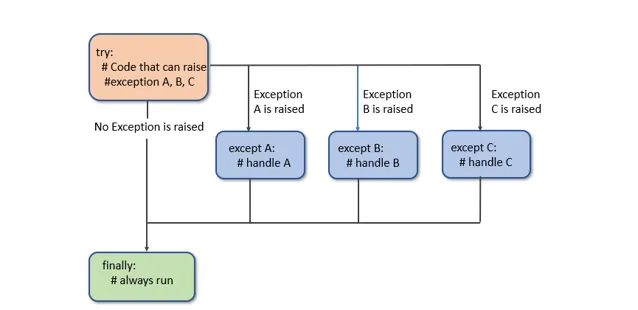來自:P**nHub兄弟網站
例外處理是寫好程式碼的一個重要的方面,雖然許多開發人員都熟悉基本的try-except塊,但是有很多更深入的知識可以使例外處理更高效、更可讀和更python化。所以本文將介紹關於Python異常的20個可以顯著改善編碼的Python例外處理技巧,這些技巧可以讓你熟練的掌握Python的例外處理。
Python中的異常是在程式執行期間發生的破壞了程式指令的正常流程的事件。與其他程式語言一樣,Python使用異常來代表錯誤發生的訊號,程式可以做出反應,並恢復或通知使用者產生的問題。
1、最簡單的例外處理
我們都知道最簡單的例外處理如下:
try:
# Your code here
except IOError:
# Handle I/O errors
except Exception as e:
# Handle other exceptions
finally:
# Cleanup, runs no matter what
異常是按階層組織的,如果發生了IOError會執行IOError的except程式碼,剩下的異常則交由Exception處理。理解這個階層可以根據需要更廣泛或更具體地捕獲錯誤。

使用finally子句確保執行清理操作,而不管是否發生異常。它非常適合關閉檔或釋放資源。
2、自訂異常
建立自訂異常可以使程式碼更具可讀性和可維護性,可以清楚地表示特定的錯誤條件。
class MyCustomError(Exception):
pass
try:
raise MyCustomError("A specific error occurred")
except MyCustomError as e:
print(e)
3、Else in Try-Except
如果沒有引發異常,則try-except塊中的else子句將執行。這是其他語言沒有的
try:
# Attempt operation
except Exception:
# Handle error
else:
# Executes if no exceptions
4、AS關鍵字
在捕獲異常時,可以使用as關鍵字將異常分配給一個變量,這樣可以顯示詳細資訊並使偵錯更容易。
try:
# Some operation
except Exception as e:
print(f"Error: {e}")
5、捕獲多個異常
元組可用於在一行中捕獲多種異常型別,從而簡化錯誤處理程式碼。
try:
# Risky operation
except (TypeError, ValueError) as e:
# Handle both exceptions
6、異常 觸發另外的異常
Python允許在使用from保持原始回溯的同時觸發新的異常,從而幫助偵錯復雜的場景。
try:
# Some operation
except Exception as original_error:
raise RuntimeError("Something bad happened") from original_error
這種方法有好有壞,所以如果不熟悉的話建議還是不要用。
7、忽略異常
使用contextlib.suppress()函式,可以優雅地忽略特定的異常,從而使程式碼更清晰、更易讀。
from contextlib import suppress
with suppress(FileNotFoundError):
# Operation that might not find a file
8、使用斷言
如果不滿足條件,可以使用斷言丟擲異常。但是要謹慎使用它們,因為它們可以透過執行時的最佳化標誌被禁用。
assert condition, "Condition was not met"
assert 斷言會丟擲AssertionError,可以在except中直接捕獲
9、格式化異常資訊
利用Traceback模組打印詳細的異常資訊,這樣可以顯示完整的錯誤來幫助偵錯。
import traceback
try:
raise ValueError("An error occurred")
except:
traceback.print_exc() # Print exception information to stderr
10、使用warnings模組發出非致命警報
warnings模組發出是警告而不是異常。如果希望在不停止程式執行的情況下提醒使用者或開發人員潛在問題時,它非常有用。
import warnings
warnings.warn("This is a warning message", UserWarning)
11、忽略異常
suppress函式被用來忽略特定的異常。contextlib可以確保資源在使用後得到適當的清理。
from contextlManaging Resources: Illustrates creating context managers for resource management, ensuring resources are properly cleaned up after use. The suppress function is shown to ignore specific exceptions.ib import contextmanager, suppress
@contextmanager
def managed_resource():
try:
resource = "Resource"
yield resource
finally:
print("Resource cleanup")
with managed_resource() as res:
print(res)
with suppress(FileNotFoundError):
open('non_existent_file.txt', 'r') # Suppresses the FileNotFoundError
12、建立處理異常的包裝器函式
functools模組可以建立一個裝飾器來包裝用於集中例外處理的函式,從而簡化跨多個函式的錯誤管理。
from functools import wraps
def exception_handler(func):
@wraps(func)
def wrapper(*args, **kwargs):
try:
return func(*args, **kwargs)
except Exception as e:
print(f"Handled exception: {e}")
return None
return wrapper
@exception_handler
def risky_function():
raise ValueError("Something went wrong")
risky_function()
13、存取異常相關的內容和函式
使用sys.exc_info()可以獲取有關當前異常的詳細資訊,這對於進一步記錄或處理錯誤細節很有用。
import sys
try:
raise TypeError("An error occurred")
except:
exc_type, exc_value, exc_traceback = sys.exc_info()
print(exc_type, exc_value)
14、分析當前異常上下文
利用inspect模組分析當前異常上下文,這對於復雜的錯誤處理場景特別有用。
import inspect
def current_exception():
for frame in inspect.trace():
if frame[3] == 'risky_function':
return frame[0].f_locals.get('e')
try:
risky_function()
except Exception as e:
print(current_exception())
15、建立動態異常類
types模組可以動態建立異常類。這對於基於執行時條件動態生成自訂異常非常有用。
import types
DynamicException = types.new_ class('DynamicException', (Exception,))
raise DynamicException("A dynamically created exception")
16、存取所有內建異常
builtins可以列出Python中可用的所有內建異常,幫助我們了解階層和各種異常。
import builtins
for name in dir(builtins):
obj = getattr(builtins, name)
if isinstance(obj, type) and issub class(obj, BaseException):
print(name)
17、自訂異常的字串表示形式
可以透過覆蓋 _ _ str _ _ 和 _ _ repr _ _ 方法來演示自訂異常,獲得更多資訊豐富的錯誤訊息。
class MyException(Exception):
def __str__(self):
return "This is a custom message for MyException"
def __repr__(self):
return "MyException()"
raise MyException
18、建立不被except Exception捕獲的異常
常規except的Exception塊會捕獲從BaseException衍生的異常,比如非常嚴重的錯誤我們可以衍生字BaseException。
class MyCriticalError(BaseException):
pass
try:
raise MyCriticalError("A critical error")
except Exception as e:
print("This will not catch MyCriticalError")
19、優雅的處理使用者和系統中斷
捕獲KeyboardInterrupt和SystemExit異常,以優雅地處理使用者或系統啟動的關機。
import sys
try:
while True:
continue
except KeyboardInterrupt:
print("User interrupted the process")
sys.exit(0)
20、生成器的資源回收
GeneratorExit表示生成器執行時產生了異常,捕獲它可以在關閉生成器時進行清理操作。
def my_generator():
try:
yield "Hello"
except GeneratorExit:
print("Generator closing")
raise
gen = my_generator()
next(gen)
gen.close()
總結
Python異常可以極大地增強程式碼的健壯性和解析度。本文整理的20個例外處理程式碼範例可以幫助你充分利用Python的錯誤處理能力,顯著改善程式碼的例外處理能力。
加入知識星球【我們談論數據科學】
600+小夥伴一起學習!












